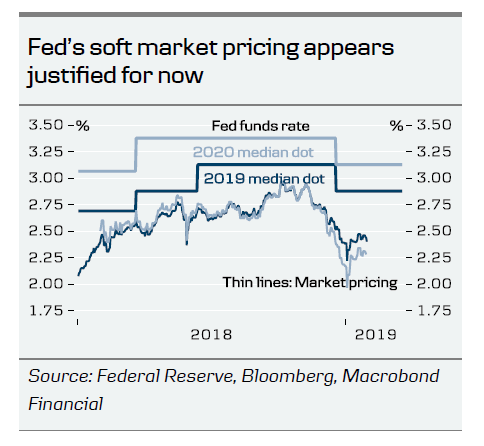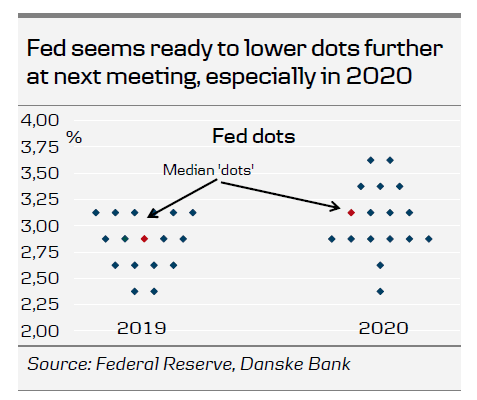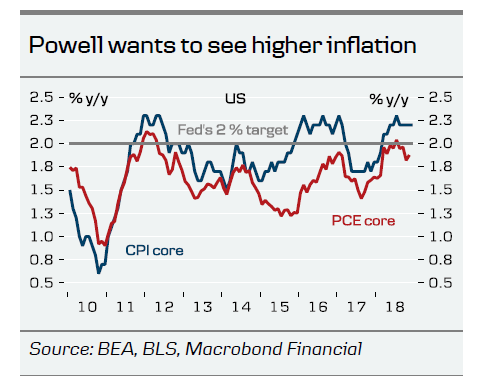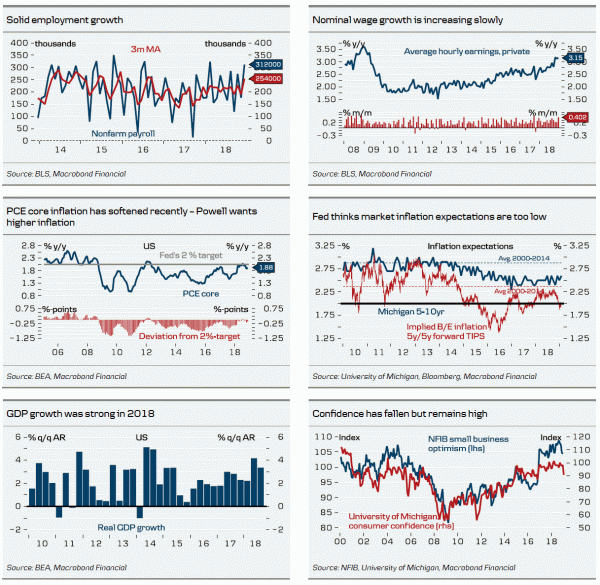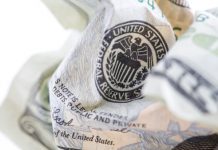As widely expected, at the meeting the Fed did not raise its target range, which remains at 2.25-2.50%. More interesting was the statement filled with changes, which reflects what we heard in speeches ahead of the meeting. The Fed no longer says that it ‘judges some further gradual increases’ are needed, and the sentence on the balance of risk was also removed. Instead, the Fed now says it can afford to be ‘patient’ for now (a word that has appeared in many speeches ahead of the meeting) ‘in light of global economic and financial developments and muted inflation pressure’. Fed Chair Powell said during his Q&A that higher inflation was ‘big part’ of what he needed to see before moving again. As noted in the FOMC minutes from the December meeting, the Fed now also recognises that market-based inflation expectations have fallen. All of the above is dovish but not a big surprise given the dovish signals in recent speeches.
Despite what we thought just a couple of months ago, the Fed does not seem to be on autopilot this year. Based on our positive macro outlook for the US and the global economy (and hence markets), we still expect the Fed to hike this year but it is no longer a given that the first one comes as early as June, which is our current base case. This is particularly true if Powell sticks to his ‘higher inflation is needed’, as we are less optimistic on the inflation outlook than the Fed is. In this light, we think current Fed market pricing seems fair for now although it is much more dovish than our base case. Markets also need to see the same things as the Fed before pricing in further hikes. We still think the Fed will end its hiking cycle this year.
The Fed also seems ready to end the balance sheet run-off sooner rather than later. The Fed released a statement saying ‘the Committee is prepared to adjust any of the details for completing balance sheet normalisation in light of economic and financial developments’. While for a long time the Fed argued that the balance sheet reduction should be as boring as watching paint dry, we have highlighted several times that the Fed may be too optimistic on how much it can reduce the supply of reserves (see for example, Research US: Fed’s regulatory hurdle for starting QT, 13 March 2017, and FX Strategy: Rise in Fed funds could put early end to QT, 26 October 2018). Powell said that the Fed is now evaluating the balance sheet run-off and that the plans would be finalised ‘at coming meetings’. This supports the view that Quantitative Tightening will end this year, perhaps by tapering the reduction pace soon. An announcement could come as early as the March meeting, or otherwise in May. We will have to look at the coming speeches to determine the exact timing, we believe.
The market welcomed the dovish signals, sending both EUR/USD and S&P500 higher. The message cements the sense of a ‘Fed on hold’, which is key to the FX market as this means the USD carry momentum is fading, notwithstanding a few more hikes down the road. The USD is vulnerable to such a shift as positioning likely remains stretched on USD longs. However, in order to see a sustained move higher from the recent range around 1.15, we believe the euro-zone cyclical outlook has to improve and this is not likely until late H1.




